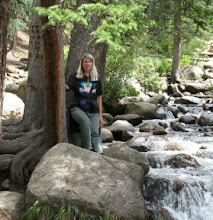Paul B. Sears called it to see the living landscape. It's pattern and wholeness and understanding, and knowing health from sickness. Well developed, we can hope it leads to appreciation, respect, and stewardship. Dave's post at Via Negativa today is a startling reminder that we, too many of us, are missing something. We have what Dave's guest writer aptly calls disconnect.
Some of my friends speak of pristine landscapes, right here in the occupied Front Range. How do we learn to understand enough to realize that this landscape, still so wondrous to me, is not pristine and has perhaps not been for hundreds or thousands of years? We live, as Aldo Leopold reminded us, in a world of wounds, but we don't see them. Here in Colorado, when the blue chicory and yellow sweet-clover bloom in profusion along our interstates, we call the Highway Department with compliments.
I know not to consider the Dalmatian toadflax on our hillsides my favorite Colorado wildflower, but I can't claim to understand the big picture after three decades here. Maybe after another lifetime of watching and caring. But guides, in the field or on the pages, may help: let me introduce you to a couple.
In his book, Reading the Forested Landscape, ecologist Tom Wessels explains how he developed his understanding of this important process:
[It was] plant ecologist Dr. John Marr... who took me into the ponderosa pine-covered foothills of Colorado's Front Range and asked me to explain why two contiguous forests were different in their composition. This process was repeated many times in my studies with Marr, and I quickly developed a new way of seeing landscapes—one that focused on their history. But Marr taught me more than the process of how to read forests. He was a rare ecologist who stressed the importance of having a strong emotional connection to landscapes alongside an analytical one. The very foundation of this book and my twenty years of teaching lies with John Marr.Marr again, and teachers in general. (I should look up what the rest of his students are doing.) Wessels also mentions May Theilgaard Watts, who links (in another direction) back to Sears. It's an incredible network and an important journey to connection. A teacher or a book can help get our feet on the path, but in the end, I suspect it's practice that makes perfect understanding.
——
Marr, John W. 1961. Ecosystems of the East Slope of the Front Range in Colorado. University of Colorado Press, Boulder.
Sears, Paul B. 1962. The Biology of the Living Landscape, an Introduction to Ecology. London, U.K., George Allen & Unwin.
Watts, May Theilgaard. 1957. Reading the Landscape, An Adventure in Ecology. MacMillan Company, New York.
Wessels, Tom. 1997. Reading the Forested Landscape, A Natural History of New England. The Countryman Press, Woodstock, Vermont.
See also, relative to shifting baselines, Natural Patriot's post on the Nature of Natural.

No comments:
Post a Comment